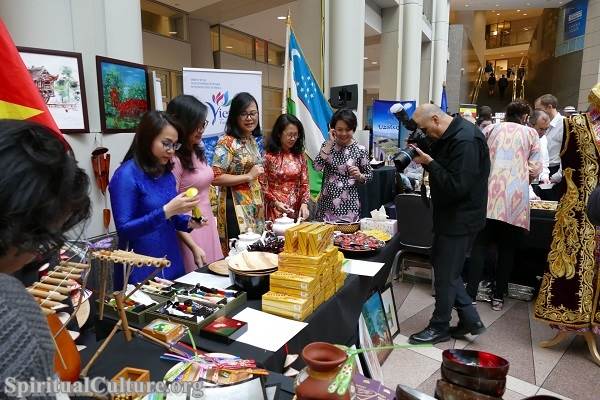Singapore, the Lion City, has always been a miraculous crossroads of culture, commerce, and belief. While its modern skyline captivates the world, the heart of its identity lies in the hawker centres—vibrant community dining rooms inscribed on UNESCO’s Representative List of the Intangible Cultural Heritage of Humanity as of December 2020. This unique culinary landscape is not merely about flavor; it is a profound spiritual expression of multicultural coexistence.
At Spiritual Culture, we approach food not just as sustenance, but as a lens into heritage. Each dish on this list tells a story of the Chinese, Malay, Indian, and Peranakan communities who adapted their ancestral recipes with locally sourced ingredients, fostering a genuine culinary fusion that celebrates shared history. The act of preparing and sharing these meals is a daily ritual of cultural cohesion, bridging different faiths and backgrounds.
As of the Current Time of Writing, in late 2025, these ten dishes remain the most recognizable, deeply loved, and culturally significant culinary anchors of Singapore. Our ranking reflects the spiritual and historical weight of each dish, judging its influence in uniting a cosmopolitan nation through the shared, sacred act of dining.
Table of Top 10 Most Famous Singaporean Foods
| Rank | Dish Name | Primary Origin | Cultural Synthesis Value | Significance/Impact (2025 Status) |
|---|---|---|---|---|
| 1 | Hainanese Chicken Rice | Hainan, China | The National Unifier (Unofficial National Dish) | Ubiquitous hawker and restaurant staple; ultimate symbol of Singaporean identity. |
| 2 | Laksa (Curry Laksa) | Peranakan/Malay-Chinese Fusion | The Peranakan Bridge (Maternal Heritage) | The perfect illustration of Chinese noodles meeting Malay/Indian spice and coconut broth. |
| 3 | Chilli Crab | Singaporean Invention (1950s) | The Celebration Dish (Communal Feasting) | Global culinary icon; messy, hands-on communal dining ritual. |
| 4 | Kaya Toast & Kopi/Teh | Hainanese/Colonial Kopitiam | The Breakfast Ritual (Daily Cultural Anchor) | A mandatory daily staple; the ultimate symbol of the Hainanese-run coffee shop (kopitiam) culture. |
| 5 | Roti Prata | Indian (South Indian Paratha) | The Indian-Muslim Staple (Community Versatility) | A versatile, essential supper and breakfast item; a testament to the Indian community’s adaptation. |
| 6 | Char Kway Teow | Chaoshan, China | The Wok Hei Soul (Laborer’s Legacy) | Represents the history of the working class and the mastery of the wok (‘breath of the wok’). |
| 7 | Bak Kut Teh | Fujian, China | The Medicinal Soup (Spiritual Comfort) | A comfort food with traditional medicinal/herbal roots; a strong Chinese community heritage marker. |
| 8 | Nasi Lemak | Malay Peninsula | The Malay Foundation (Fragrant Beginnings) | Malay foundational dish; rice cooked with coconut milk and pandan, a core component of regional cuisine. |
| 9 | Fish Head Curry | Singaporean Invention (South Indian/Chinese Fusion) | The Multiracial Invention (Pioneer Spirit) | Specifically created by a South Indian chef to appeal to Chinese diners, representing direct cultural fusion. |
| 10 | Satay | Malay/Javanese | The Street Food Icon (The Esplanade Tradition) | A national favorite for communal grilling and late-night gatherings, often paired with Ketupat (rice cakes). |
#10. Satay
Satay, thin skewers of marinated and charcoal-grilled meat, is the quintessential Singaporean street food experience, a legacy largely inherited from the Malay and Javanese culinary traditions. Paired with a rich, sweet-and-spicy peanut sauce and often served with compressed rice cakes (ketupat), cucumbers, and onions, it represents the joyous, smoky heart of Singapore’s communal late-night dining. Its presence at old venues like the Satay Club underscored its role as a unifying national snack, a tradition upheld in modern hawker centers as of Current Time of Writing.
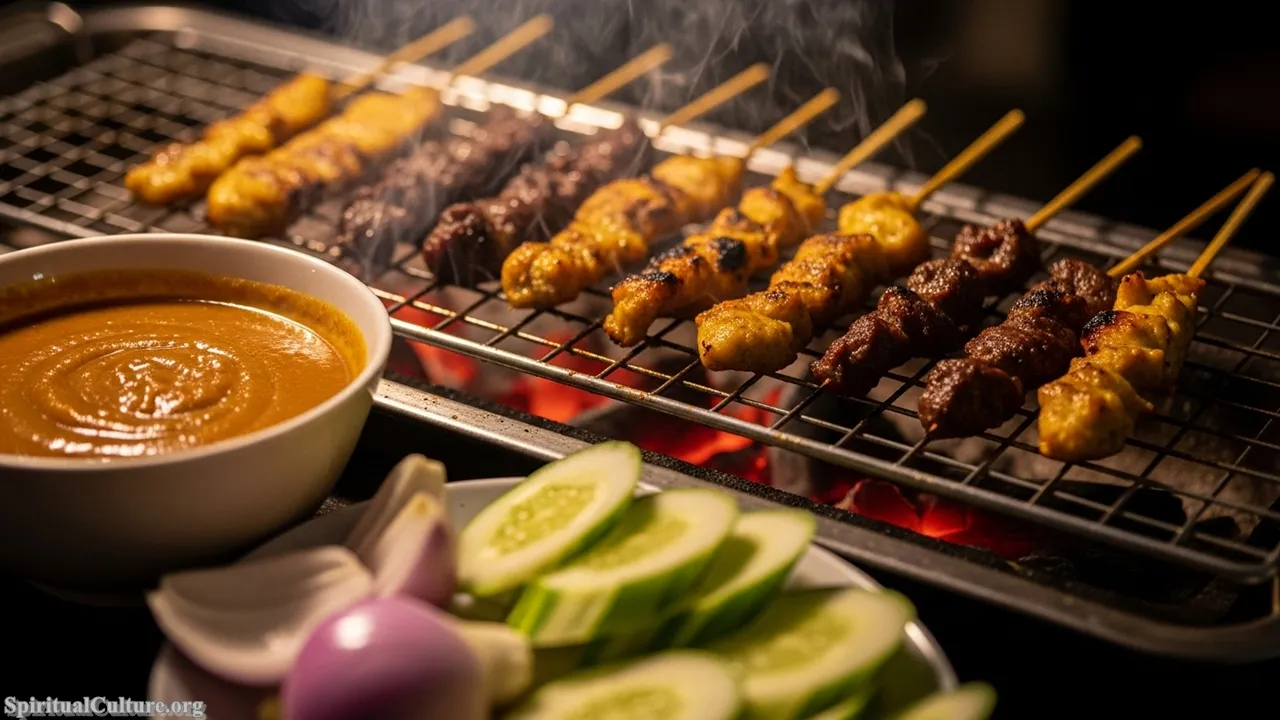
The spiritual impact of Satay lies in its participatory and festive nature. Grilling meat over charcoal is an ancient, ritualistic practice, transforming basic ingredients into a celebratory feast. The pairing with ketupat, particularly consumed during Eid al-Fitr, subtly links this hawker staple to profound spiritual observance, extending its cultural reach across Singapore’s multi-ethnic population. It embodies a spontaneous, shared moment of pleasure, transcending daily life’s complexities.
The preservation value of Satay lies in the dedication of hawkers to the traditional charcoal grilling method, which imparts the essential ‘wok hei’ or smoky aroma. The moral lesson it offers is one of simple perfection: profound flavor can be achieved through fundamental techniques and the communal effort of shared preparation and dining.
Cultural/Spiritual Highlights
- Fuses Malay/Javanese grilling traditions with Chinese/Indian accessibility.
- Historically tied to the famous open-air Satay Club, symbolizing spontaneous communal gathering.
- Often served with ketupat (rice cakes), linking it subtly to Malay spiritual festivals.
#9. Fish Head Curry
Fish Head Curry, a bold and tangy dish featuring a Red Snapper head simmered in a rich, spicy, and often coconut-milk-based curry, is a pioneering example of Singapore’s culinary adaptability. This dish was invented in the 1970s by a South Indian chef, M. J. Gomez, who sought to appeal to his Chinese clientele—who highly valued fish heads—by combining them with his native Indian spices. This direct, intentional fusion makes it a tangible piece of Singapore’s multicultural heritage.
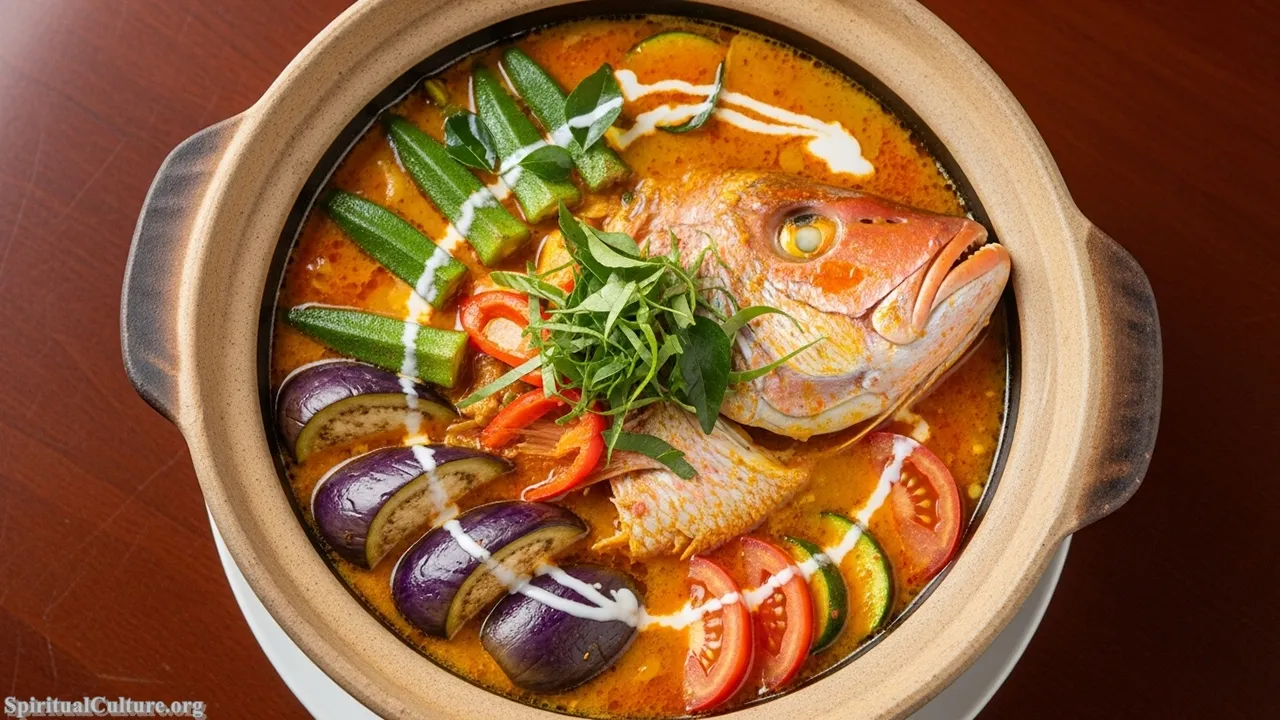
The reason for its high ranking is its narrative of harmonious, calculated cultural exchange. It is a dish born of inter-ethnic understanding and commercial spiritualism. The spiritual impact is found in the tradition of sharing the large fish head, symbolizing unity and a shared “head start” in life, common in Chinese banqueting. It is a powerful illustration of how new cultural spaces can be forged through food, rather than merely inherited.
This culinary invention reflects the pragmatic, pioneering spirit of Singapore. It teaches that true cultural creativity often comes from seeking to understand and satisfy the needs of one’s neighbors. Its continued popularity demonstrates the success of this early, deliberate act of cross-cultural blending, a testament to the nation’s ability to synthesise.
Cultural/Spiritual Highlights
- A documented Singaporean invention created explicitly for cross-cultural appeal.
- Blends South Indian spices (curry) with Chinese culinary preference (fish head).
- Communal nature of the dish symbolises unity and shared prosperity.
#8. Nasi Lemak
Nasi Lemak, a Malay foundational dish, translates literally to “fatty/rich rice” and is one of Southeast Asia’s most fragrant staples. The spiritual quality of this dish is found in the rice itself, which is meticulously cooked in coconut milk and pandan leaves, imparting a creamy, comforting aroma. Traditionally served wrapped in a banana leaf, this packaging elevates the simple meal into an aesthetic and aromatic experience, often accompanied by fried anchovies, peanuts, a hard-boiled egg, and a potent sambal chilli.

The dish ranks highly because it is a direct link to the island’s indigenous Malay heritage, forming a bedrock for the subsequent layers of Singaporean cuisine. Its spiritual impact lies in its use as a breakfast staple—a sanctifying start to the day. The fragrant, almost-sweet coconut rice is the offering, connecting the diner to the agricultural roots and the simple, profound pleasures of the land and its staples.
The use of the banana leaf, an indigenous, organic container, speaks to a deep connection to the natural world and a sustainable simplicity often lost in modern food preparation. Nasi Lemak is a living reflection of Singapore’s roots, a dish that reminds its people of the foundational culture upon which the modern metropolis was built, demanding respect for simplicity and nature.
Cultural/Spiritual Highlights
- The fragrant coconut rice and pandan leaves create a deeply comforting, almost sacred, aroma.
- A foundational, indigenous dish of the Malay community and the wider region.
- Traditional banana leaf wrapping symbolises a connection to nature and simplicity.
#7. Bak Kut Teh
Bak Kut Teh, or “pork bone tea,” is a Chinese-origin soup featuring meaty pork ribs simmered for hours in a complex broth, with variations typically leaning toward the peppery Teochew style or the herbal Hokkien style in Singapore. This dish arrived with Fujian and Teochew immigrants, who were primarily hard laborers working at the port and along the Singapore River. It was originally seen as a fortifying, restorative soup, a medicinal tonic to boost strength for the demanding work ahead.
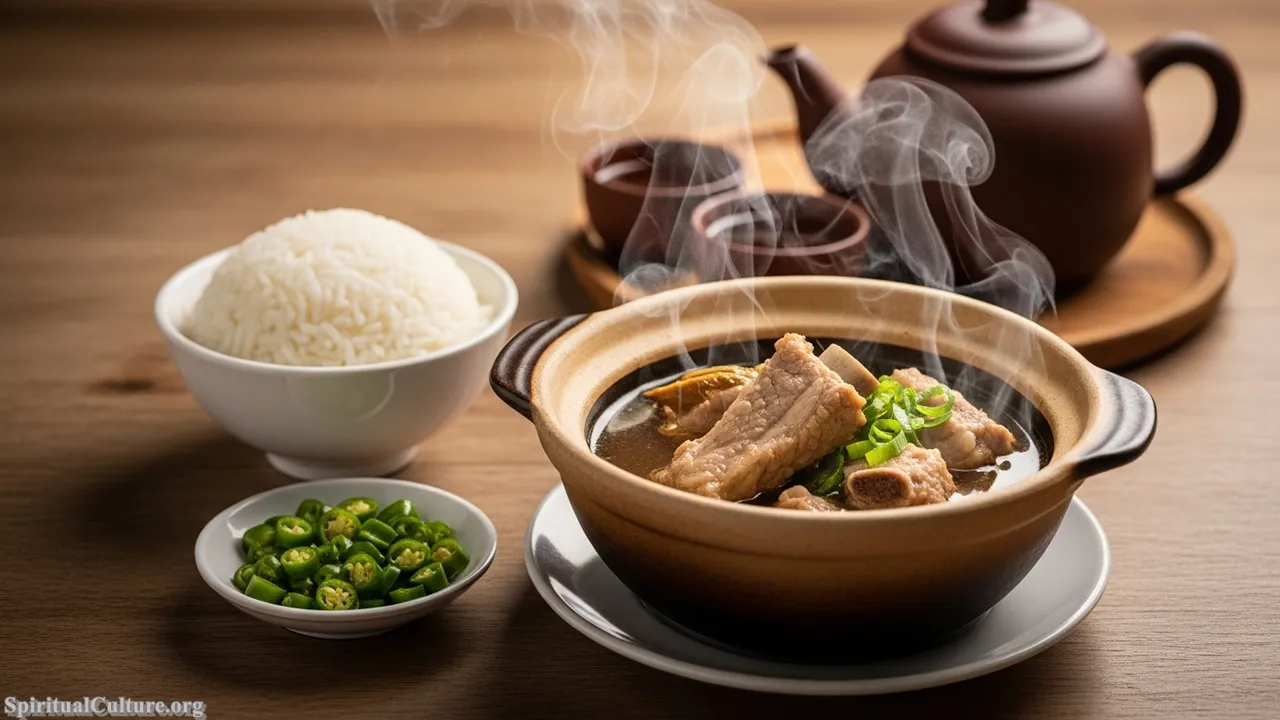
The spiritual impact of Bak Kut Teh stems directly from its medicinal and restorative purpose. It is a ritual of comfort and recovery, a warm hug for the soul, particularly among the Chinese diaspora. The term “tea” originally referred to the strong Chinese tea that is traditionally sipped alongside the soup to cut the richness of the pork and aid digestion, creating a balanced, harmonizing experience central to traditional Chinese well-being.
The continued devotion to this dish—and the fierce loyalty to specific hawker stalls known for their unique broth recipe—underscores its preservation value as a cultural heirloom. It represents the perseverance and physical dedication of Singapore’s early migrant workers. The moral lesson is the spiritual benefit of fortitude, symbolized by the deep, concentrated flavor extracted patiently from simple bones.
Cultural/Spiritual Highlights
- Its origins as a medicinal, fortifying tonic for Chinese laborers.
- Symbolic connection to spiritual well-being and physical fortitude.
- The ritual of pairing the soup with strong Chinese tea to restore balance.
#6. Char Kway Teow
Char Kway Teow, flat rice noodles stir-fried over incredibly high heat with dark soy sauce, chilli, cockles, egg, and Chinese sausage, is a dish that speaks directly to the soul of the Singaporean working-class past. Translating to “stir-fried ricecake strips” in Hokkien, this dish originated as an inexpensive, high-calorie meal for laborers, fishermen, and farmers. Its defining characteristic is the elusive, smoky aroma known as Wok Hei (“breath of the wok”), which requires immense skill and control from the hawker, almost a spiritual communion with the flame.
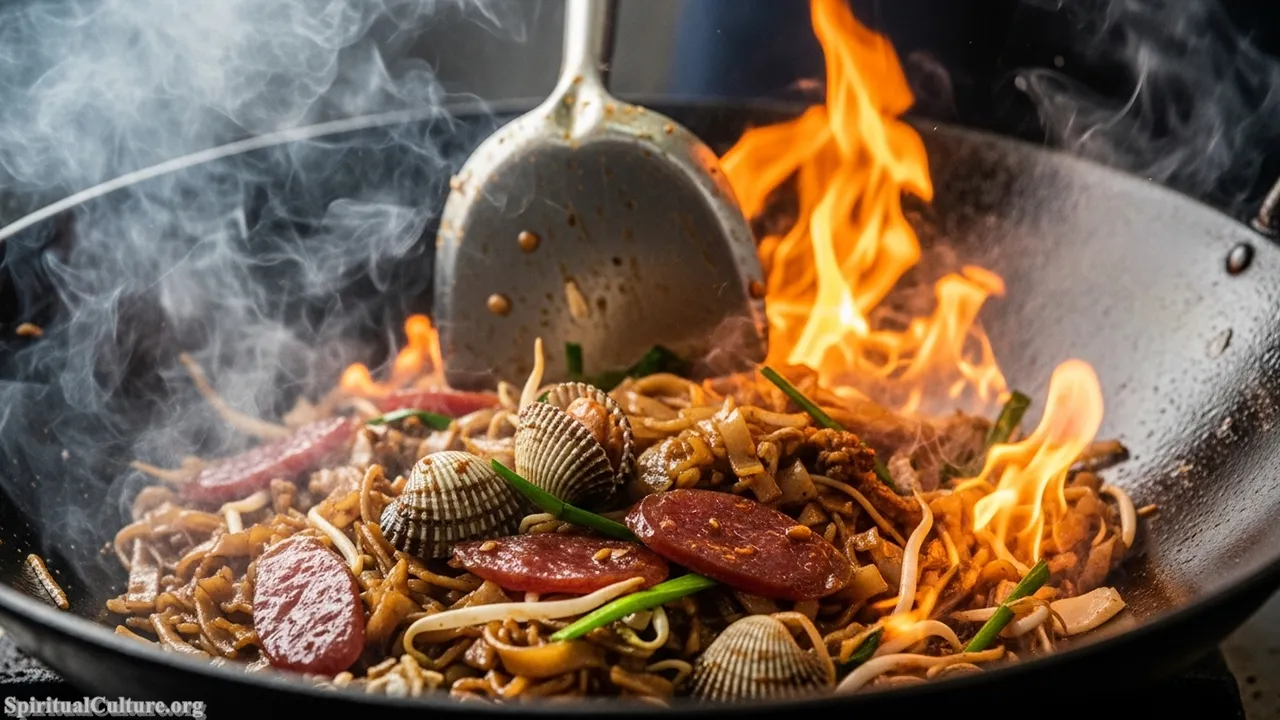
It earns its spot high on the list due to the almost mystical quality of Wok Hei. This is the spiritual impact: the breath of the wok is a non-tangible ingredient, an energy transfer that elevates simple ingredients into culinary poetry. The ability to perfectly imbue the dish with this smoky essence is a deeply respected craft, passed down through the generations of hawkers, representing the mastery of skill over raw power.
This dish is a vibrant, greasy, and undeniably beautiful tribute to humility and hard work. The spiritual preservation of Char Kway Teow is tied to the existence of the hawkers who still practice the arduous, high-heat method. It is a savory reminder that Singapore’s prosperity was built on the sweat and skill of its pioneers, and that true excellence is found in the dedicated mastery of a craft.
Cultural/Spiritual Highlights
- Defined by Wok Hei (Breath of the Wok), a mastery-based spiritual energy transfer.
- Originates as an affordable, high-energy meal for the working class and pioneers.
- Represents the historical confluence of various Chinese dialect groups in one dish.
#5. Roti Prata
Roti Prata, a local evolution of the South Indian Paratha, is a flaky, crispy, and often elastic flatbread made by repeatedly tossing and flipping the dough to incorporate air and develop layers before being pan-fried in ghee. This dish is an omnipresent fixture in Singapore’s Indian-Muslim stalls, serving as a flexible staple for breakfast, supper, or late-night feasting. It is typically served plain (kosong) or with fillings like egg or onion, accompanied by various fish or mutton curries.
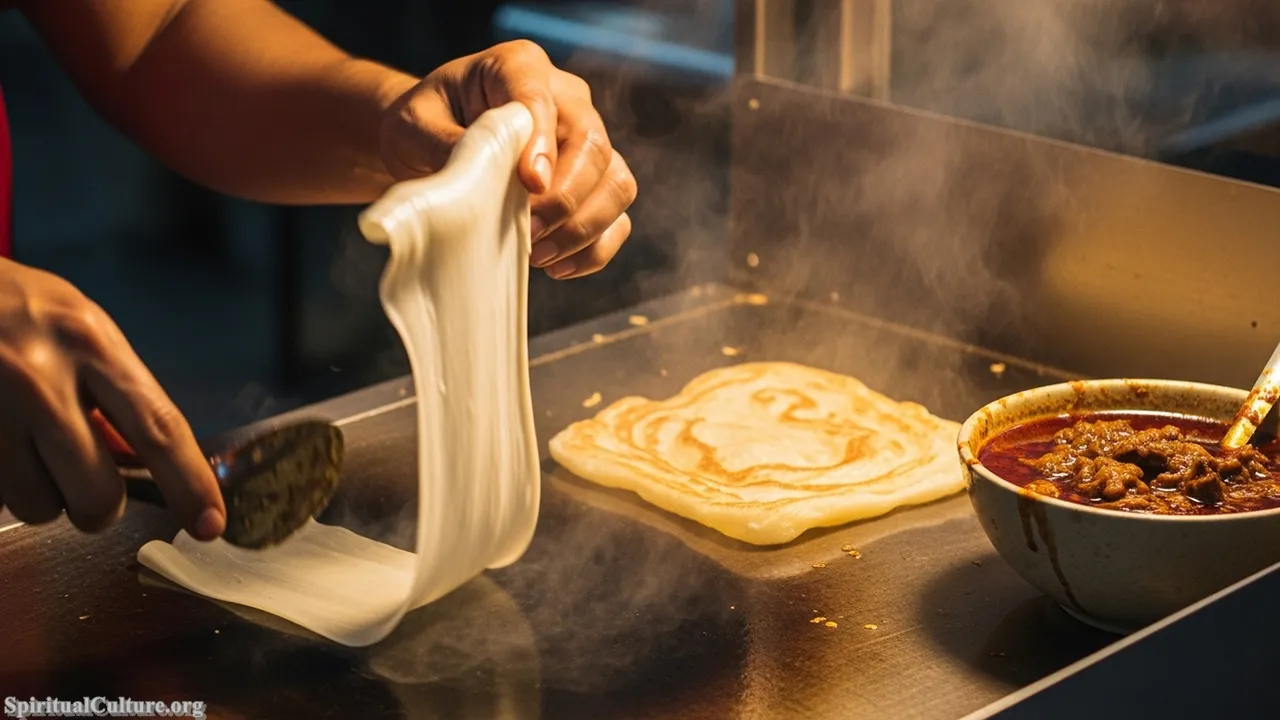
The spiritual culture of Roti Prata is embedded in its daily, accessible ritual. It is a comfort food that bridges the gap between different meals and different social groups. The mesmerising dance of the dough-flapping hawker is a visible art form, a performance of skill and dedication that entertains and reassures diners of its freshness. This culinary spectacle turns the preparation process itself into a moment of cultural appreciation.
Roti Prata’s preservation is ensured by its sheer versatility and appeal across all races, making it a powerful testament to the influence and integration of the Indian-Muslim community within Singaporean life. It teaches a moral lesson of adaptability: a simple flatbread can be transformed into endless variations, from a plain savory staple to a decadent dessert, reflecting the dynamic nature of Singaporean culture itself.
Cultural/Spiritual Highlights
- The visible craft of ‘flipping’ the dough is a public performance of dedication.
- A staple of the Indian-Muslim community, showcasing seamless cultural integration.
- Versatile usage (sweet or savory) symbolises the flexible, adaptable nature of the community.
#4. Kaya Toast & Kopi/Teh
The Kaya Toast set, featuring crispy toasted bread spread with Kaya (a fragrant jam of coconut milk, eggs, and pandan), a slab of cold butter, and paired with runny soft-boiled eggs and a cup of robust local coffee (Kopi) or tea (Teh), is the quintessential Singaporean breakfast. This tradition was pioneered by Hainanese immigrants who, after working as cooks for wealthy British and Peranakan families during the colonial era, opened their own coffee shops (kopitiams) and synthesized a uniquely local, affordable breakfast.
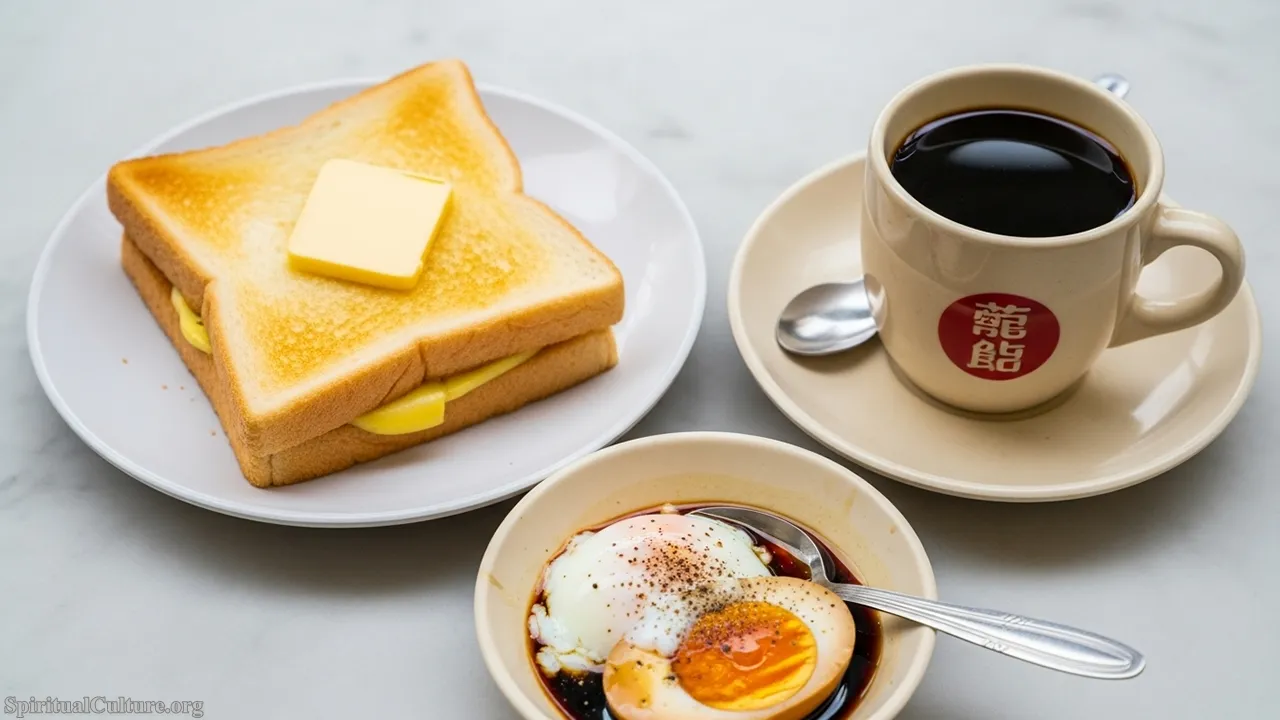
This daily ritual is a deeply meaningful cultural anchor, earning its rank through sheer, consistent spiritual adherence by the populace. The kopitiam is a hallowed space of daily congregation, where people from all walks of life gather. The perfect pairing—the salty butter meeting the sweet kaya, the dip of the toast into the soy-sauce-seasoned egg—is a sacred equilibrium, a foundational ritual that grounds the soul before the day begins.
Kaya Toast is a potent symbol of cross-cultural adaptation and entrepreneurship. It reflects the Hainanese ingenuity in creating something new from the culinary remnants of the colonial past and Peranakan ingredients. Its preservation is paramount, as the small, unpretentious kopitiams are the temples of this daily worship, teaching that profound cultural identity can be found in the simplest, most consistent habits.
Cultural/Spiritual Highlights
- The kopitiam (coffee shop) is a sacred, essential communal gathering space.
- A daily ritual that provides spiritual grounding before the start of the workday.
- Represents the Hainanese community’s historical role as cultural synthesizers.
#3. Chilli Crab
Chilli Crab, featuring large mud crabs stir-fried in a rich, sweet, savory, and mildly spicy tomato-chili sauce, is not only a world-famous Singaporean dish but also a relatively recent invention, often credited to Madam Cher Yam Tian in the mid-1950s. Served with deep-fried Chinese buns (mantou) for dipping, this dish represents the pinnacle of communal, celebratory feasting and the nation’s passion for fresh seafood, reflecting its maritime history.

Its spiritual significance is found entirely in the act of communal dining and physical engagement. Eating Chilli Crab is a messy, hands-on activity that forces diners to put aside formality, use their fingers, and bond over the shared struggle of cracking shells. This physical, uninhibited interaction breaks down social barriers, making the meal a powerful ritual of togetherness and genuine camaraderie that speaks directly to Singapore’s unifying ethos.
The preservation of Chilli Crab lies in its status as a celebratory dish, marking special occasions and family gatherings. It embodies the humanistic value of shared abundance and the idea that the greatest joy is often found in the most indulgent and messy shared experiences. It stands as a confident statement of Singapore’s culinary identity, bold, flavorful, and uniquely its own.
Cultural/Spiritual Highlights
- Represents a key Singaporean invention, cementing its modern identity.
- The messy, hands-on eating process is a profound ritual of communal bonding.
- A celebration dish symbolizing abundance, joy, and maritime heritage.
#2. Laksa (Curry Laksa)
Laksa is arguably the perfect bowl of Singaporean cultural fusion, combining rice noodles in a rich, spicy coconut milk-based curry broth (Laksa Lemak), traditionally served with prawns, cockles, and fish cake. Its most famous variant, Katong Laksa, is strongly associated with the Peranakan (Straits-born Chinese) community, whose cuisine is a sophisticated blend of Chinese ingredients and cooking techniques with Malay/Indonesian spices. This dish is the very definition of a cultural bridge.
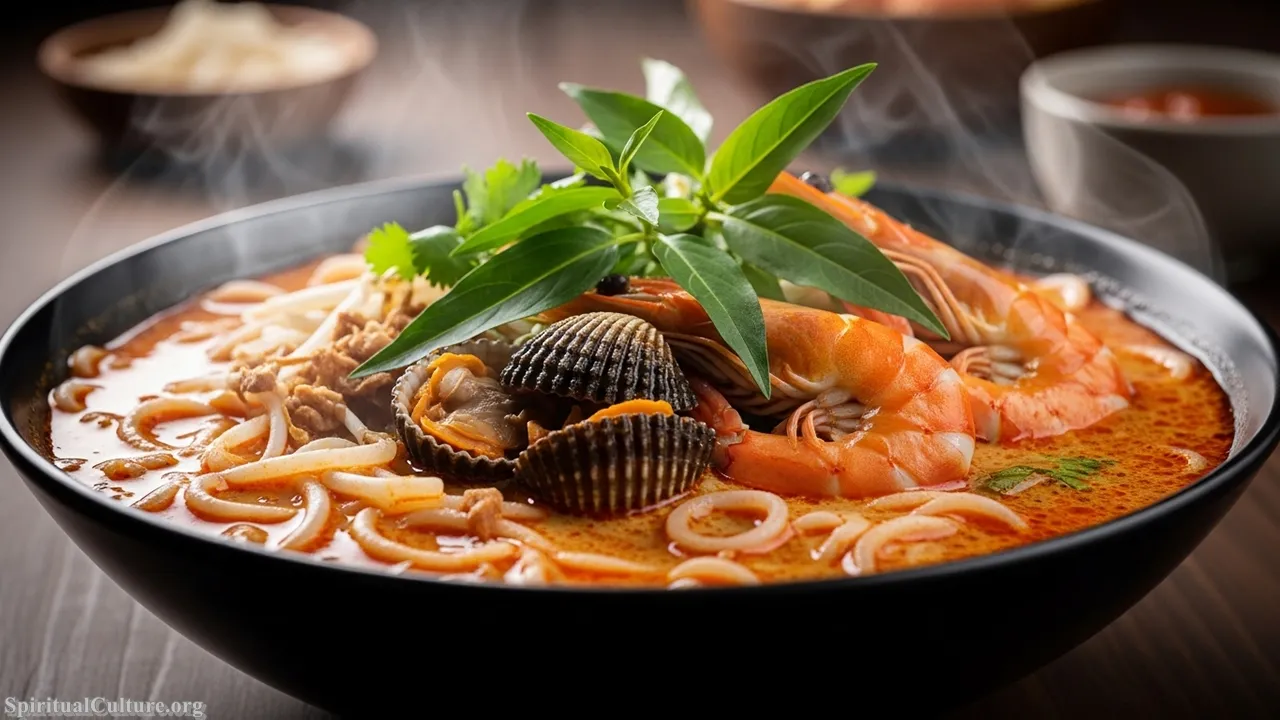
Laksa ranks as the highest form of culinary synthesis on this list. Its spiritual impact is deeply intertwined with the Peranakan identity, a heritage that sought harmony between two great Asian cultures. The creaminess of the coconut milk (Malay influence) meets the texture of the Chinese noodles, while the blend of chillies and spices (Indian/Malay influence) creates a flavor profile that is uniquely Singaporean. It is a savory, aromatic meditation on fusion, representing the successful intermingling of ancient traditions.
The moral lesson of Laksa is that diversity does not have to lead to dilution; instead, it can lead to something richer, bolder, and more beautifully complex. Protecting the authentic preparation of Laksa, especially the laborious curry paste base, is the preservation of the delicate, spiritual balance of the Peranakan past, ensuring its profound cultural narrative endures.
Cultural/Spiritual Highlights
- The ultimate synthesis of Chinese, Malay, and Indian flavors/ingredients.
- Represents the profound heritage and culinary artistry of the Peranakan community.
- The rich broth symbolizes the comfort and enveloping warmth of cultural harmony.
#1. Hainanese Chicken Rice
Hainanese Chicken Rice, a deceptively simple dish of poached or roasted chicken served with rice cooked in chicken fat, ginger, and pandan, along with specific dipping sauces (chili, ginger, and dark soy), stands unchallenged as the unofficial national dish of Singapore. Introduced by immigrants from Hainan, China, it has evolved from its ancestral Wenchang chicken roots to become an elegant, ubiquitous staple, found everywhere from humble hawker stalls to Michelin-starred restaurants.

The undisputed Rank #1 is based on its profound spiritual and cultural status as the ultimate unifier. The genius of the dish is that the chicken is merely the vessel; the fragrant rice is the soul, infused with the essence of the entire process. This focus on the rice reflects the foundational importance of this grain in Asian culture—it is the breath of life, the sacred staple. Because virtually every Singaporean, regardless of race or religion, loves and claims this dish, it transcends all ethnic boundaries and serves as a secular sacrament of national identity.
Hainanese Chicken Rice is the perfect encapsulation of the Singapore story: taking an imported idea, refining it, and elevating it to a new standard of excellence and universal appeal. Its preservation value is immeasurable, representing the collective memory of the nation. The moral lesson is that perfection lies in harmony and balance—the simple triumvirate of chicken, rice, and sauce—a direct reflection of Singapore’s success as a harmonious multicultural society, a spiritual beacon in late 2025.
Cultural/Spiritual Highlights
- The unofficial National Dish and ultimate symbol of Singaporean identity.
- The rice, cooked in chicken stock and aromatics, is the spiritual core of the meal.
- Loved and consumed by all ethnic groups, representing perfect national harmony and unity.
- A refinement of an ancestral Chinese dish, perfected through local ingenuity.
Conclusion
The food of Singapore is more than just a menu; it is the most delicious, tangible expression of its history, its ingenuity, and its ultimate spiritual success. From the unifying simplicity of Hainanese Chicken Rice to the complex harmony of Laksa, each dish on this Spiritual Culture Top 10 list is a living piece of Intangible Cultural Heritage. They are daily reminders that in the modern world, the most enduring legacy a nation can possess is the ability for diverse cultures to share a table, celebrating their differences while finding comfort in their shared, beloved flavors. This ongoing culinary conversation is the true spirit of Singapore—warm, profound, and deeply humanistic.

